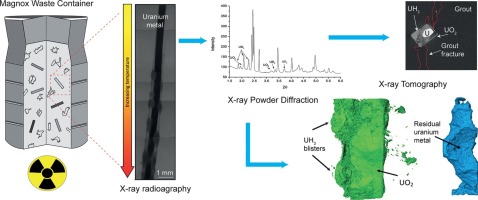Real time, in-situ deuteriding of uranium encapsulated in grout; effects of temperature on the uranium-deuterium reaction
To accurately predict the initiation and evolution of uranium hydride potentially present in nuclear waste containers, studies of simulated conditions are required.

Here, for the first time, the uranium-deuterium reaction was examined in-situ, in real time, whilst within grouted media. A deuterium gas control rig and stainless steelquartz glass reaction cell were configured on a synchrotron beam line to collect X-ray diffraction and X-ray tomography data. It was found that deuteride formation was limited by the uranium and grout thermal conductivities and deuteride initiation only commenced above a threshold temperature. Strong adherence between uranium oxide and grout was also observed.
In the UK, challenges have arisen regarding the safe packaging and storage of Intermediate Level nuclear Waste (ILW), which has now been classified as highly active waste due to the processing of Magnox uranium metal fuel. The ILW consists of de-canned Magnox swarf and irradiated uranium metal which have been encapsulated in a grout, sealed in 500 L stainless steel containers and subsequently left in storage where corrosion has progressed in a moist, highly alkaline, environment